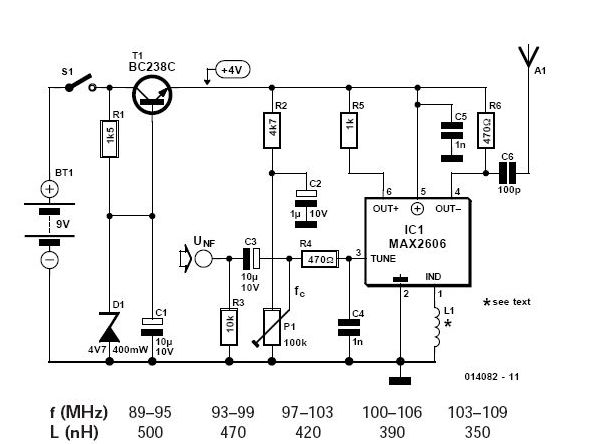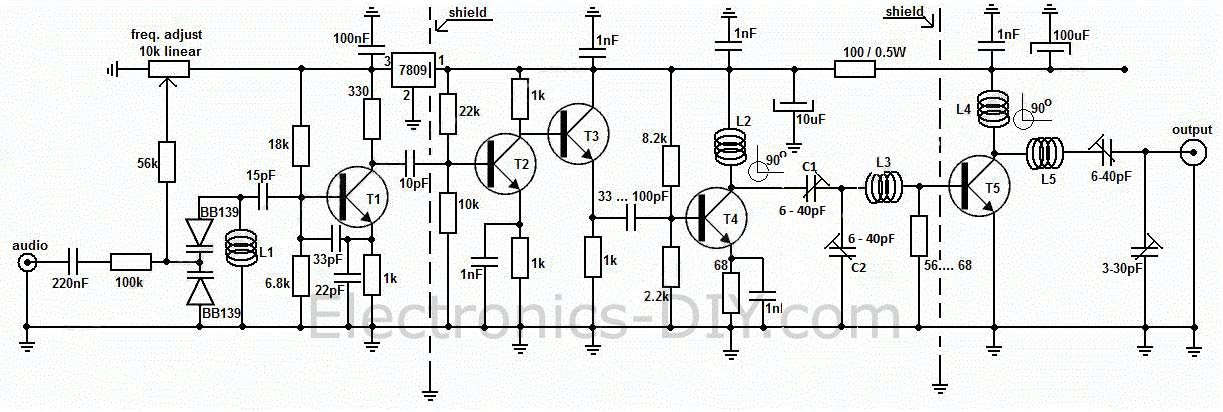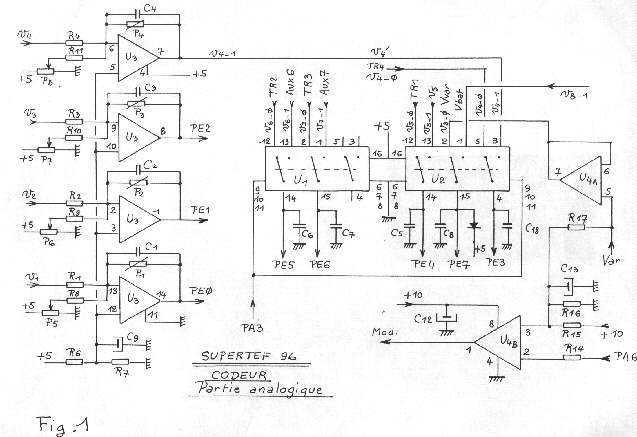
Tracking Transmitter

This is a small battery-operated tracking transmitter that broadcasts a repeating radio signal detectable by a directional antenna. The transmitter emits an isotropic signal across the FM band, specifically between 87 to 108 MHz. An ordinary FM radio can be employed to locate the transmitter, with signal reception improving when the radio antenna is directed toward the transmitter. The device utilizes a standard Hartley oscillator, with an adjustable transmit frequency controlled by trimmer capacitor C8. The resonant frequency is determined by the combined capacitance of capacitors C4 and C8 along with inductor L1. The modulation is achieved through an interrupted square wave signal generated by all four gates of a CD4011 integrated circuit. Gates U1 and U2 interrupt the signal at approximately 2 Hz, while gates U3 and U4 produce a higher tone within the audio range. The output from U4 modulates the base of transistor Q1 via resistor R3. Due to the square wave modulation, the radiated signal contains harmonics across the FM band, which can assist in locating the transmitter. The tuning of the transmitter is accomplished using the tank circuit formed by L1 and the parallel capacitance of C4 and C8, where L1 is approximately 0.15 µH. The inductor is constructed with 7 turns of 20 SWG wire wound on a 6 mm drill bit, resulting in an inductance of approximately 150 nH. The inductance value can be adjusted by compressing or expanding the coil turns. The winding process involves holding one end of the wire against the drill bit and winding it clockwise until all 7 turns are completed. After winding, any excess wire should be trimmed to ensure both ends are of equal length, and approximately 3 mm of insulation should be removed from the opposite end. For those interested in winding their own coils, a JavaScript calculator for tuned circuits is available on the author's webpage for convenience. For instance, using a diameter of 6 mm (0.6 cm) and a length of 1 cm, a desired inductor of 0.15 µH corresponds to approximately 7.33 turns.
The small battery-operated tracking transmitter is designed for efficient signal transmission and reception. It operates within the FM band, making it compatible with standard FM radios, which enhances its usability. The Hartley oscillator configuration is notable for its simplicity and effectiveness in generating stable frequencies, making it ideal for tracking applications. The adjustable frequency feature allows users to fine-tune the transmitter for optimal performance in various environments.
The modulation technique employed, utilizing a square wave, introduces harmonics that can be beneficial for signal detection. This characteristic may result in a "dirty" signal, but it enhances the transmitter's locatability, which is a critical aspect of tracking systems. The careful selection of components, such as the CD4011 gates for modulation, demonstrates the design's focus on achieving a reliable output.
The construction of the inductor L1 is a key element in the tuning process. The specified wire gauge and winding technique ensure that the inductor meets the desired inductance value. The ability to adjust inductance by compressing or expanding the coil turns provides flexibility in achieving the required resonant frequency, which is essential for the transmitter's operation.
Overall, this tracking transmitter exemplifies a well-thought-out design that balances simplicity, effectiveness, and user adaptability, making it a valuable tool for various tracking applications.This is a small battery operated Tracking transmitter which broadcasts a repeating radio signal which can be detected by a directional antenna. The transmitter broadcasts an isotropic (radiates in all directions) signal on the FM band. An ordinary FM radio can be used to locate the transmitter, the reception of the signal will improve when the rad
io antenna is pointed in the direction of the transmitter. The transmitter is a standard hartley oscillator, designed to transmit across the FM band approximately, 87 to 108MHz. The transmit frequency is adjustable by means of trimmer C8. The combined capacitance of C4 plus C8 and L1 set the resonant frequency. Modulation for the transmitter is an interrupted square wave signal using all 4 gates of a CD 4011. Gates U1 and U2 interrupt the signal at about 2Hz while gates U3 and U4 create a higher tone in the audio range.
The output of U4 applies this modulation to the base of Q1 via R3. Because the modulation is a squarewave, the radiated signal becomes a little bit "dirty" and harmonics will be heard across the FM band. This is not a big problem as it will aid in locating the transmitter. The transmitter is tuned by the tank circuit L1 and parallel capacitance of C4 plus C8. L1 is approximately 0. 15 uH. The value of "C" in the equation below is the sum of C4 plus C8. L1 is 7 turns of 20swg wire wound on a 6 mm drill bit. This forms an inductor of approximately 150 nH. The value of the inductance can be altered by compressing or expanding the turns. Hold one end of the wire against the drill bit and start to wind the turns clockwise. Continue until all 7 turns have been completed, and the coil looks like the image of the right hand side.
Trim any excess wire so both ends are same length and scrape about 3mm of insulation off the opposite end. For anyone wishing to wind their own coils, Ron J kindly submitted a javascript calculator, on my tuned circuit page.
It is presented here again for convenience. For example using a diameter of 6mm (0. 6cm) and 1cm length, a desired inductor of 0. 15uH works out at 7. 33 turns. 🔗 External reference
The small battery-operated tracking transmitter is designed for efficient signal transmission and reception. It operates within the FM band, making it compatible with standard FM radios, which enhances its usability. The Hartley oscillator configuration is notable for its simplicity and effectiveness in generating stable frequencies, making it ideal for tracking applications. The adjustable frequency feature allows users to fine-tune the transmitter for optimal performance in various environments.
The modulation technique employed, utilizing a square wave, introduces harmonics that can be beneficial for signal detection. This characteristic may result in a "dirty" signal, but it enhances the transmitter's locatability, which is a critical aspect of tracking systems. The careful selection of components, such as the CD4011 gates for modulation, demonstrates the design's focus on achieving a reliable output.
The construction of the inductor L1 is a key element in the tuning process. The specified wire gauge and winding technique ensure that the inductor meets the desired inductance value. The ability to adjust inductance by compressing or expanding the coil turns provides flexibility in achieving the required resonant frequency, which is essential for the transmitter's operation.
Overall, this tracking transmitter exemplifies a well-thought-out design that balances simplicity, effectiveness, and user adaptability, making it a valuable tool for various tracking applications.This is a small battery operated Tracking transmitter which broadcasts a repeating radio signal which can be detected by a directional antenna. The transmitter broadcasts an isotropic (radiates in all directions) signal on the FM band. An ordinary FM radio can be used to locate the transmitter, the reception of the signal will improve when the rad
io antenna is pointed in the direction of the transmitter. The transmitter is a standard hartley oscillator, designed to transmit across the FM band approximately, 87 to 108MHz. The transmit frequency is adjustable by means of trimmer C8. The combined capacitance of C4 plus C8 and L1 set the resonant frequency. Modulation for the transmitter is an interrupted square wave signal using all 4 gates of a CD 4011. Gates U1 and U2 interrupt the signal at about 2Hz while gates U3 and U4 create a higher tone in the audio range.
The output of U4 applies this modulation to the base of Q1 via R3. Because the modulation is a squarewave, the radiated signal becomes a little bit "dirty" and harmonics will be heard across the FM band. This is not a big problem as it will aid in locating the transmitter. The transmitter is tuned by the tank circuit L1 and parallel capacitance of C4 plus C8. L1 is approximately 0. 15 uH. The value of "C" in the equation below is the sum of C4 plus C8. L1 is 7 turns of 20swg wire wound on a 6 mm drill bit. This forms an inductor of approximately 150 nH. The value of the inductance can be altered by compressing or expanding the turns. Hold one end of the wire against the drill bit and start to wind the turns clockwise. Continue until all 7 turns have been completed, and the coil looks like the image of the right hand side.
Trim any excess wire so both ends are same length and scrape about 3mm of insulation off the opposite end. For anyone wishing to wind their own coils, Ron J kindly submitted a javascript calculator, on my tuned circuit page.
It is presented here again for convenience. For example using a diameter of 6mm (0. 6cm) and 1cm length, a desired inductor of 0. 15uH works out at 7. 33 turns. 🔗 External reference





